In the vast and intricate world of oil drilling, acronyms play a critical role in communication and understanding. They serve as shorthand for complex terms and processes, making conversations between professionals more efficient. Among these acronyms, the term “oil rig acronym” stands out, representing a collective understanding of the various components and operations involved in oil extraction. As the oil industry continues to evolve, an awareness of these acronyms becomes essential for those involved in the field, whether they are seasoned professionals or newcomers seeking to make their mark.
As the global demand for oil remains high, the significance of oil rigs and their operations cannot be overstated. These structures are vital for extracting the crude oil that fuels economies and powers industries worldwide. Understanding the oil rig acronym not only aids in grasping the technical aspects of oil drilling but also enriches one's knowledge of the industry's language and culture. In this article, we will explore the meaning and significance of oil rig acronyms, their applications, and how they facilitate better communication within the industry.
The oil rig acronym is not just a collection of letters; it embodies the essence of the operations carried out on offshore and onshore platforms. By delving deeper into this topic, we can uncover the various terms that make up this acronym and their importance in the industry. This understanding is crucial for anyone looking to navigate the complexities of oil extraction and contribute to its future.
What are the Common Oil Rig Acronyms?
When it comes to oil rigs, several acronyms are frequently used. Here are some of the most common:
- API: American Petroleum Institute
- FPSO: Floating Production Storage and Offloading
- RIG: Rig Inspection Guide
- HSE: Health, Safety, and Environment
- SEMS: Safety and Environmental Management Systems
Why is Understanding Oil Rig Acronyms Important?
The oil and gas industry is characterized by its technical nature, and understanding the related acronyms is essential for several reasons:
- Effective Communication: Using acronyms allows for clearer and quicker exchanges among professionals.
- Safety Compliance: Many acronyms relate to safety protocols, making them vital for maintaining safe working conditions.
- Streamlined Operations: Familiarity with industry terms enhances efficiency in operations and project management.
How Do Oil Rig Acronyms Evolve Over Time?
As the oil industry grows and adapts to new technologies and regulations, so do its acronyms. New terms may emerge, and existing ones may evolve to reflect changes in operations, safety standards, or technological advancements. Keeping abreast of these changes is crucial for professionals in the field.
What Are Some Lesser-Known Oil Rig Acronyms?
While many are familiar with common acronyms, several lesser-known terms are equally significant:
- LOA: Length Overall
- OPEX: Operational Expenditure
- CAPEX: Capital Expenditure
- MWD: Measurement While Drilling
Are There Regional Variations in Oil Rig Acronyms?
Indeed, different regions may use specific acronyms based on local practices, regulations, or languages. Professionals working in international contexts should be aware of these variations to avoid misunderstandings.
Can Oil Rig Acronyms Impact Safety Protocols?
Acronyms related to safety, such as HSE and SEMS, directly influence workplace protocols. Understanding these terms is crucial for ensuring compliance with safety regulations and minimizing risks on oil rigs.
How Can Newcomers Learn Oil Rig Acronyms?
For newcomers to the oil industry, familiarizing themselves with acronyms can seem daunting. Here are some strategies to aid in learning:
- Training Programs: Many companies offer training that covers industry terminology.
- Mentorship: Seeking guidance from experienced professionals can provide invaluable insights.
- Online Resources: Websites and forums dedicated to the oil industry often provide glossaries of terms and acronyms.
Conclusion: The Role of Oil Rig Acronyms in the Industry
In conclusion, understanding the oil rig acronym is vital for anyone involved in the oil and gas sector. These acronyms facilitate effective communication, enhance safety protocols, and streamline operations, making them essential tools for professionals. As the industry continues to evolve, staying informed about new terms and their meanings will be crucial for success. Whether you are a seasoned expert or a newcomer, embracing the language of the oil industry will undoubtedly pave the way for better opportunities and collaborations.
Celebrating Excellence: A Look Back At The 70th Emmy Awards
Unraveling The Escalator Meme: A Cultural Phenomenon
Unmasking The Mexican Spiderman Meme Phenomenon


